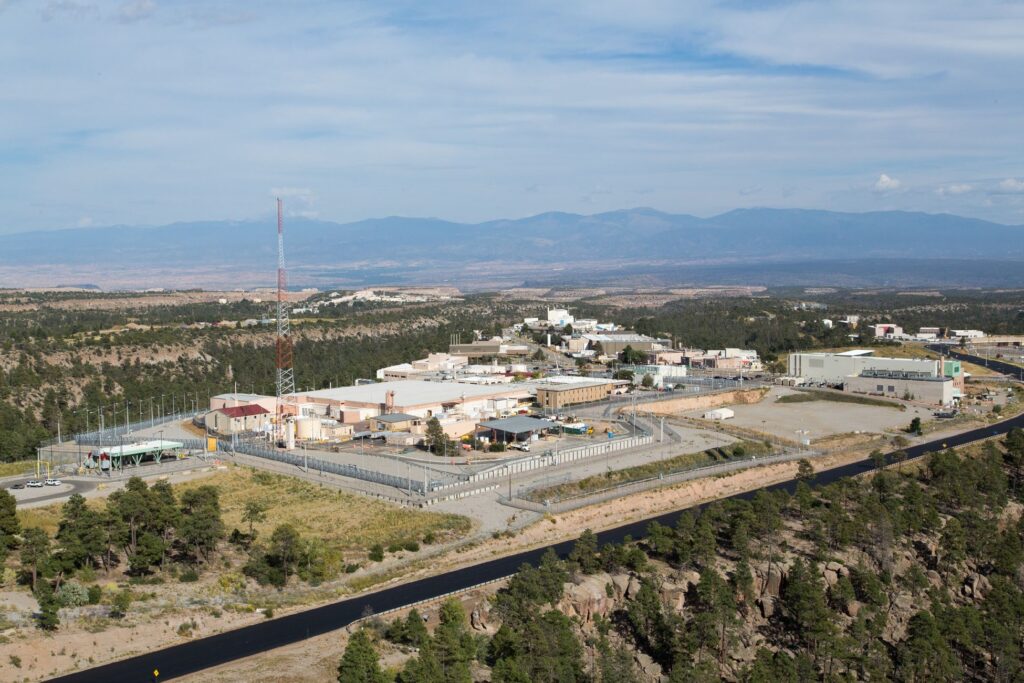An undated photo capturing the Plutonium Facility at Los Alamos National Labratory, with the Rio Grande valley and the Sangre de Cristo mountains in the background. (Photo courtesy of Los Alamos National Laboratory)
U.S. energy officials illegally neglected to study impacts to the environment in efforts to increase plutonium production for nuclear weapons in New Mexico and South Carolina, a federal judge has ruled.
South Carolina District Court Judge Mary Geiger Lewis sided with environmental, anti-nuclear proliferation and community groups last week who sued the National Nuclear Security Administration (NNSA), which oversees the nuclear weapons stockpile as part of the U.S. Department of Energy.
The U.S. is investing billions into restarting the manufacture of plutonium “pits,” the grapefruit-sized spheres developed for nuclear weapons. The federal government halted its manufacturing program at the Rocky Flats Plant in Colorado in 1989 after an FBI raid due to safety concerns and environmental crimes.
The stated goal has been to produce 80 pits per year starting in 2030, split between Savannah River facility proposed in South Carolina and at Los Alamos National Laboratory in New Mexico. The project has faced safety concerns and delays. The Government Accountability Office, a federal watchdog agency, found the NNSA had no comprehensive timeline or cost estimate for pit production, but estimates it’s in the tens of billions of dollars.
Scientist says there’s legacy plutonium contamination in Los Alamos
Community, environment and anti-nuclear groups brought the lawsuit in 2021, alleging that the NNSA failed to consider alternatives to its two-site proposal and violated the law by not reviewing or changing its last analysis from 2008, when it approved the decisions to move forward in 2020.
The federal law at the heart of the case is the National Environmental Policy Act (known as NEPA), which requires the federal government to “carefully consider” impacts to the environment in proposed actions.
Geiger Lewis wrote that the NNSA “failed to conduct a proper study on the combined effects of their two-site strategy. And, they have neglected to present a good reason for their decision.”
Geiger Lewis dismissed four other allegations by environmental groups, including concerns about nuclear waste storage and transport, finding that they did not meet the legal requirements for consideration.
She was unsatisfied with either party’s requests for addressing the problem, writing that she would not reverse the federal government’s decisions made for the program. Instead, the written order directed the groups to come together and create a joint, third option to the court within 14 days.
The federal government asked for a 10-day extension, due to impacts from Hurricane Helene, which Geiger Lewis granted on Monday. Now, the parties have until Oct. 25 to present a joint proposal to resolve NNSA’s noncompliance for Geiger Lewis to approve.
One of the plaintiffs, Jay Coghlan, the executive director of Nuclear Watch New Mexico called that a “pretty large hurdle to overcome,” for both parties. It’s unclear what happens if the parties fail to present a joint solution.
“That remains to be seen, we don’t know,” Coghlan said.
Work on the plutonium pit production program, such as construction of facilities, is ongoing, said Milli Mike, a spokesperson for the NNSA.
“We’ve reviewed the Court’s ruling and are supporting the Department of Justice as it prepares to meet and confer with the plaintiffs, as ordered,” Mike said in a written statement.
The Los Alamos National Laboratory declined to comment, and referred Source New Mexico’s questions to the NNSA.

